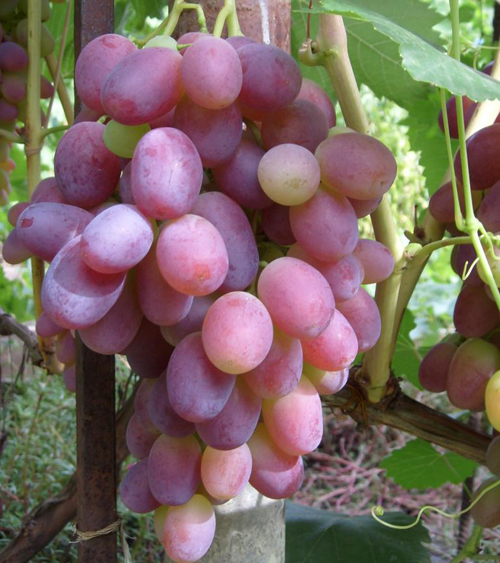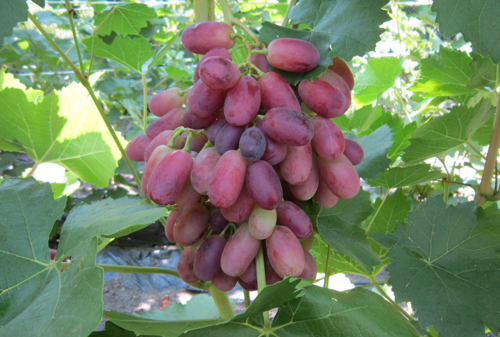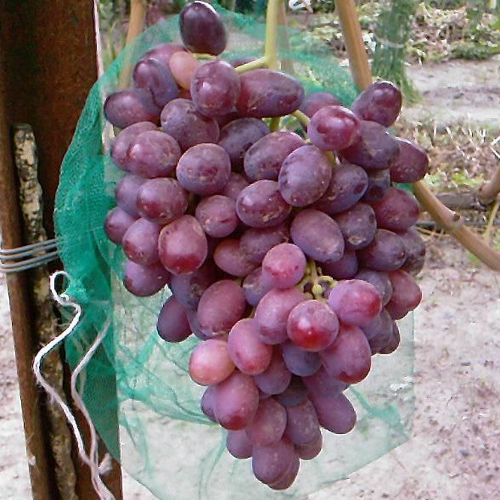Rizamat grape variety
Rizamat is a legendary Uzbek variety of table-raisin grapes with amazingly large, sweet and attractive fruits, as well as a very high yield. Received by breeders of the Samarkand branch of the Research Institute of Horticulture and Viticulture named after R.R. Schroeder in the 70s of the XX century by crossing the local varieties Katta-Kurgan and Parkent. The authors of the masterpiece were R.V. Ogienko, K.V. Smirnov and A.F. Gerasimov. They gave the name to their brainchild in honor of the outstanding winegrower of the Uzbek SSR, Hero of Socialist Labor, laureate of the Stalin Prize, Honorary Academician of the Republican Academy of Sciences Rizamat Musamukhamedov.

The new variety of grapes turned out to be so successful in taste and aesthetic qualities that it itself later became the parental form for many hybrids, but none of them could be compared by tasting ratings with the unsurpassed Rizamat.
The downside of such remarkable qualities was the pickiness to growing conditions and the exactingness of the variety to a high level of agricultural technology. Unfortunately, our hero not only does not differ in any significant frost resistance, but also demonstrates susceptibility to the most harmful diseases of the vine. Due to its low winter hardiness, after passing the state variety test, it was zoned only in the southernmost regions of the USSR - Turkmenistan, Uzbekistan and Georgia. However, it was so fond of amateur winegrowers that they spread it far beyond the borders of these republics. Today, the famous grape variety can be found on household plots in Russia, Kazakhstan, Ukraine, where, thanks to the caring hands of admirers of the variety, it gives high yields of excellent quality, even at the cost of significant labor costs.
Agrobiological characteristics
The bushes are vigorous. The leaves are round, medium-sized, five-lobed, slightly dissected. The lateral notches are barely marked, the petiole is open, vaulted, with a rounded bottom. The denticles along the edge of the leaf blade are large, triangular with a wide base. Leaf pubescence is absent. Rizamat is perfectly pollinated with its own pollen due to bisexual flowers, but it has a certain tendency to pea.

Bunches of grapes are large (average weight 600-800 grams), up to 17-18 cm long, cylindrical in shape, branched, with a free loose arrangement of berries. The comb is long, fragile. The berries of the variety are very large, oblong with a blunt end, 45 × 25 mm in size and weighing 9-15 grams. The pulp is firm, sweet, juicy, crispy in an oriental way, melting in the mouth. The taste is very bright, harmonious, refreshing, without specific varietal characteristics. The skin is thin, easily edible, of an attractive intense pink color, covered with a white protective waxy coating of medium intensity. The bones are small, almost invisible when used. The grape tasting score is high - 9.1 points. After ripening, the harvest of Rizamat is not recommended to be left on the bushes, since overripe berries change their taste not for the better, can be damaged by wasps and crack due to changes in soil moisture.
The crop is intended for fresh consumption, the manufacture of raisins and use in the confectionery industry. Possesses high indicators of marketability and transportability. Beautiful elongated berries of elegant colors delight the eye of the grower and attract the attention of buyers. It is not suitable for long-term storage.
Early-medium variety.The growing season is 135-145 days. At home, it sings in the second half of August, later in more northern regions. The sum of active temperatures required for full ripening is 2950-3050 ° C, which is quite a lot even for central Russia. The yield of Rizamata, subject to good care, is very high - 200-250 c / ha. A formed bush in a covering culture is capable of producing more than 10 kg of grapes, and in the southern latitudes, powerful 15-20-year-old bushes cultivated on arches without shelter for the winter give 50-70 kilograms of bunches of excellent quality. The number of fruiting shoots is small and amounts to 40-50%. The number of clusters on them is on average 0.4-0.6. Ripening of the vine is good, but this does not save it from the winter cold due to the low frost resistance of the variety. The bushes are severely damaged even at a temperature of -16 -18 ° C. The sugar content of the juice of berries is 18-22 grams / 100 ml, the acidity is 5-6 grams / l.

Agrotechnical features
The cultivation of this variety of grapes is possible only with careful and high-quality care for it. Even reproduction has its own difficulties, since the variety is unstable to phylloxera, which requires grafting on a phylloxera-resistant stock, and Rizamat's fusion with them is weak. Therefore, it is preferable to reproduce it in a self-rooted culture, but it is possible only in regions free from harmful soil pests. By the way, in fairness, it is worth noting that cuttings take root in moist soil very well.
At the stage of the growth of the bushes, it is necessary to decide on their formation, and if you do not live in a subtropical climate, then most likely you will have to stop at covering forms in order to maintain the viability of pampered plants in winter. The shelter should be solid and of high quality, simplified options with hilling the vine with earth are definitely not suitable for this variety. The best results are shown by multi-layer shelters using heat-insulating organic materials - straw, sawdust, pine needles or reed mats.
At the same time, it is necessary to work out the system of protecting grapes from diseases. This will require multiple spraying of Rizamat with fungicides against mildew and powdery mildew. As a preventive measure, good results are given by such agrotechnical methods as debris, pinching, thinning of leaves in order to ensure free access of air and ventilation of the bushes. It is not allowed to pinch the shoots of this variety, because of which dormant buds can wake up and a catastrophic thickening of the bush will occur.
When a vineyard enters fruiting, it is necessary, among other things, to monitor the load of the bushes with crops and shoots. Overloading them, of course, is quite difficult due to the low fertility of the vine, but the recommended load in the pursuit of the harvest should not be exceeded. In the spring, it is necessary to leave about 35-45 eyes on the grapes, while the pruning should be long - 10-15 buds, since the lower eyes of Rizamat are mostly sterile.
The variety responds well to watering and feeding, but they should not be abused in order to avoid cracking of the berries and a general decrease in their quality. Growers also respond positively to the treatment of inflorescences with a growth stimulator Gibberellin. If you approach this event strictly according to the instructions for using the drug, you can get a significant increase in the size and weight of berries, which, of course, will have a positive effect on the total weight of the crop.
In order to achieve the most attractive color of Rizamata bunches, it is necessary to clarify them during ripening, removing all leaves that prevent sunlight from reaching the berries. It is also worthwhile to provide for the protection of the bunches quickly gaining sugar from damage by wasps. Harvesting must be carried out immediately upon reaching the removable maturity, without overexposing the grapes on the bushes.Only for the manufacture of raisins in hot dry climates, the bunches are left to hang for another 2-3 weeks, drying it in this way. Fresh, they can be stored for a short time in ventilated cool rooms with low air humidity.
Thus, in the case of Rizamat, we are dealing with a very productive plant capable of producing a high-quality crop, but only under the condition of competent and conscientious care of it. Many growers consider such labor costs excessive and unjustified, calling the variety a relic of the past, but its true connoisseurs and admirers will never agree with them, stubbornly cultivating grapes that are whimsical and so unique in their characteristics.








